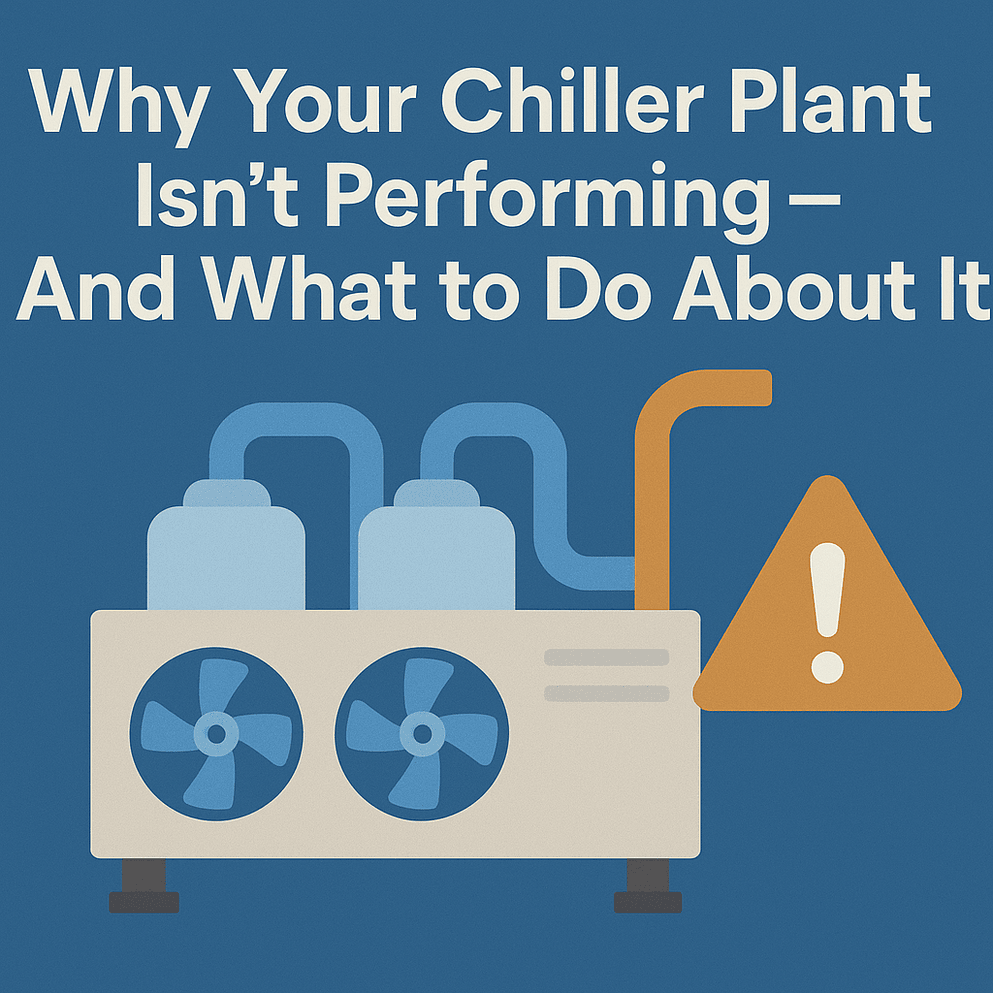When your chiller plant begins to underperform, the impact goes beyond just uncomfortable occupants — it hits your energy bills, equipment life, and operational efficiency. For many industrial and commercial facilities, the chiller plant represents the largest single energy consumer, often accounting for up to 40–60% of total building energy use. So, when efficiency drops, the costs can skyrocket.
Let’s explore the most common reasons your chiller plant isn’t performing as expected — and more importantly, what you can do to fix it.
1. Poor Maintenance Practices
The Problem:
Neglecting maintenance schedules is one of the leading causes of chiller inefficiency. Dirty condenser tubes, fouled heat exchangers, and degraded refrigerant levels can all reduce heat transfer efficiency. Even a small layer of scale or fouling on heat exchange surfaces can increase energy consumption by 10–20%.
The Solution:
- Implement a preventive maintenance program that includes regular tube brushing, chemical cleaning, and refrigerant testing.
- Monitor and log key performance metrics such as approach temperature, pressure differential, and compressor amperage.
- Use vibration analysis and oil sampling to detect mechanical wear before failures occur.
Consistent maintenance not only improves efficiency but also extends equipment life — a win-win for any facility manager.
2. Improper System Balancing
The Problem:
Your chiller plant’s efficiency depends on the balance between chilled water and condenser water flows. If the system isn’t hydraulically balanced, you’ll experience issues like short-cycling, uneven cooling, and wasted pump energy.
The Solution:
- Perform a hydronic system balancing at least annually.
- Install variable frequency drives (VFDs) on pumps and fans to match system demand.
- Use flow meters and differential pressure sensors for real-time monitoring and adjustment.
A properly balanced system ensures that every part of your plant — from chillers to AHUs — operates within optimal parameters.
3. Outdated Controls and Sensors
The Problem:
Many facilities still rely on manual control systems or outdated BAS logic. Without modern analytics, chillers often run at full load unnecessarily, leading to energy waste. Additionally, drifting sensors can cause incorrect readings and poor system responses.
The Solution:
- Upgrade to smart building automation systems (BAS) with predictive analytics and optimization algorithms.
- Calibrate sensors regularly to ensure accuracy.
- Use IoT-enabled controls that can automatically adjust setpoints based on occupancy and load conditions.
With intelligent controls, your plant can dynamically adjust operations for maximum efficiency — saving energy without compromising comfort.
4. Oversized or Undersized Equipment
The Problem:
If your chiller is too large, it short cycles and operates inefficiently at part loads. If it’s too small, it struggles to meet demand, running continuously and wearing out faster. Both situations lead to high energy costs and reduced reliability.
The Solution:
- Conduct a chiller load analysis to match capacity with actual building demand.
- Consider modular or staged chiller systems that allow capacity scaling.
- For oversized systems, integrate load-shedding or sequencing controls to optimize part-load operation.
A right-sized plant is crucial for maintaining steady performance and avoiding unnecessary energy loss.
5. Inefficient Cooling Tower Operation
The Problem:
Your cooling tower plays a critical role in chiller efficiency. Poor heat rejection, due to mineral scaling, fan malfunction, or low airflow, can cause the chiller to work harder. This leads to higher compressor lift and increased energy consumption.
The Solution:
- Keep cooling tower basins clean and manage water chemistry to prevent scaling.
- Inspect fill media and drift eliminators regularly.
- Use VFDs and fan staging to modulate tower performance based on condenser water temperature.
- Install automatic bleed and make-up systems to maintain water quality.
Optimizing your cooling tower can improve overall chiller efficiency by as much as 10–15%.
6. Ignoring Data Analytics
The Problem:
Without data-driven insights, you’re flying blind. Many facilities still rely on manual logs or monthly reviews rather than continuous monitoring. This delays detection of performance issues such as low delta-T syndrome or abnormal compressor cycles.
The Solution:
- Deploy a chiller plant optimization platform that tracks performance metrics in real-time.
- Use trend analysis and fault detection diagnostics (FDD) to identify inefficiencies early.
- Integrate data with your CMMS (Computerized Maintenance Management System) for automated alerts and reporting.
Analytics empower your team to move from reactive to proactive — preventing costly downtime and improving energy efficiency.
7. Lack of Operator Training
The Problem:
Even the best chiller plant won’t perform well if operators aren’t trained. Misunderstanding controls, improper sequencing, or manual overrides can destroy efficiency gains.
The Solution:
- Invest in regular training and certification programs for plant operators.
- Provide standard operating procedures (SOPs) for startup, shutdown, and emergency conditions.
- Encourage data literacy, so teams understand what system metrics mean and how to act on them.
A knowledgeable operator can make the difference between an efficient plant and an energy drain.
Final Thoughts: Turning Performance Problems into Savings
Your chiller plant is the heart of your facility’s HVAC system, and when it underperforms, every process feels the strain. But the good news is that every inefficiency can be corrected with the right combination of maintenance, optimization, and technology upgrades.
By taking a system-level approach — focusing not just on the chiller but the entire plant ecosystem — you can reduce energy costs, extend equipment life, and improve occupant comfort.
If your chiller plant isn’t delivering the performance you expect, it’s time to investigate, optimize, and modernize — because in today’s energy-conscious world, inefficiency isn’t just expensive, it’s unsustainable.


